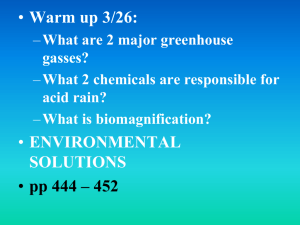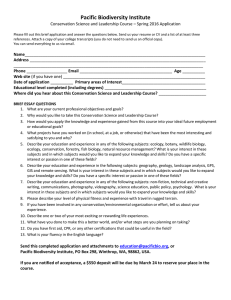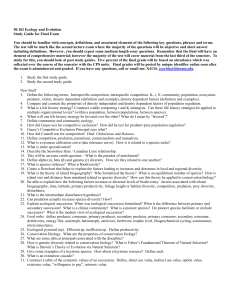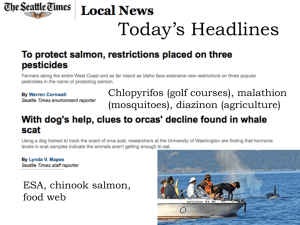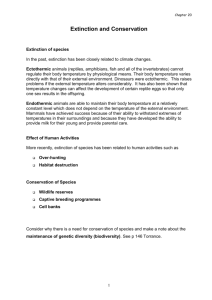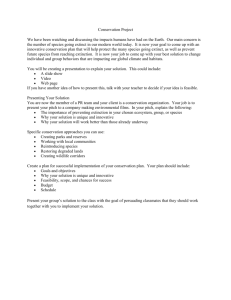Grades 6-10 - lesson_plan_on_extinction
advertisement
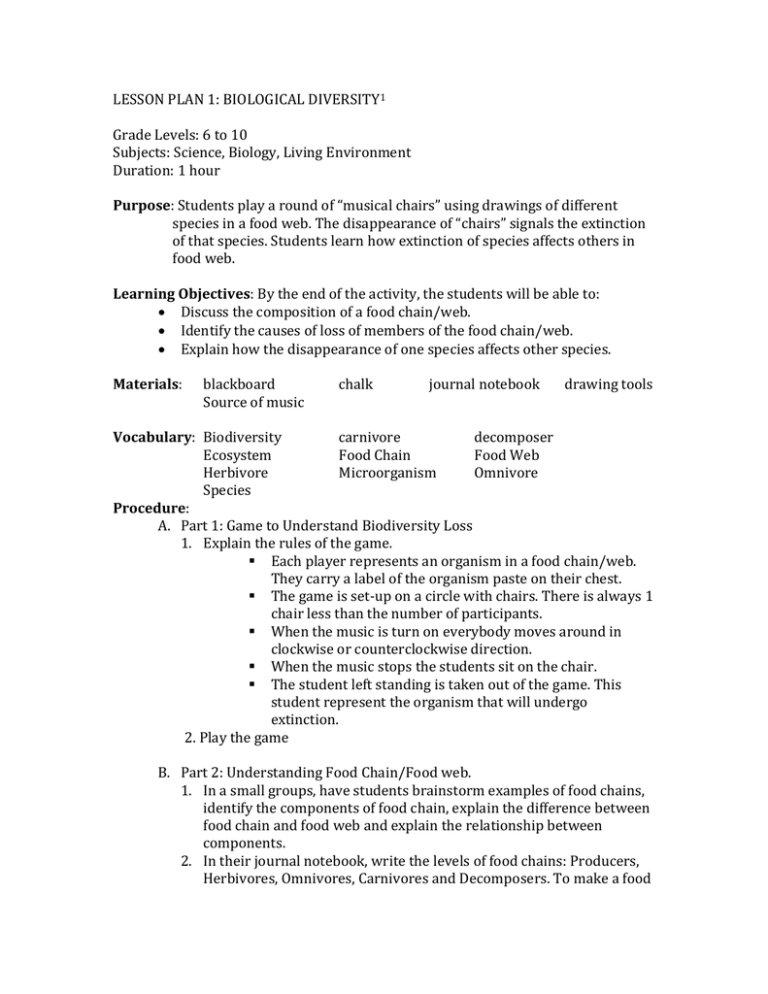
LESSON PLAN 1: BIOLOGICAL DIVERSITY1 Grade Levels: 6 to 10 Subjects: Science, Biology, Living Environment Duration: 1 hour Purpose: Students play a round of “musical chairs” using drawings of different species in a food web. The disappearance of “chairs” signals the extinction of that species. Students learn how extinction of species affects others in food web. Learning Objectives: By the end of the activity, the students will be able to: Discuss the composition of a food chain/web. Identify the causes of loss of members of the food chain/web. Explain how the disappearance of one species affects other species. Materials: blackboard Source of music chalk journal notebook drawing tools Vocabulary: Biodiversity carnivore decomposer Ecosystem Food Chain Food Web Herbivore Microorganism Omnivore Species Procedure: A. Part 1: Game to Understand Biodiversity Loss 1. Explain the rules of the game. Each player represents an organism in a food chain/web. They carry a label of the organism paste on their chest. The game is set-up on a circle with chairs. There is always 1 chair less than the number of participants. When the music is turn on everybody moves around in clockwise or counterclockwise direction. When the music stops the students sit on the chair. The student left standing is taken out of the game. This student represent the organism that will undergo extinction. 2. Play the game B. Part 2: Understanding Food Chain/Food web. 1. In a small groups, have students brainstorm examples of food chains, identify the components of food chain, explain the difference between food chain and food web and explain the relationship between components. 2. In their journal notebook, write the levels of food chains: Producers, Herbivores, Omnivores, Carnivores and Decomposers. To make a food web, there should be multiple organisms for each level. There should be arrows directing to the organisms that are being eaten. Explain that the connections between species are why biodiversity is sometimes called the “the web of life”. (PLEASE SEE ATTACH SAMPLE) C. Part 3: Processing the activity. 1. Ask the students “what could have made the particular species from the game to go extinct?” 2. Ask the students how humans, human activities can affect food webs in both positive and negative ways. 3. Let the students come up with ways to solve problems on the continues degradation of biodiversity. 4. Since they are divided into groups, ask individual member to make their own food chain, after which all members of the group will find ways to combine all their food chains to make up a food web. 5. Write their food web on a chart paper, and share it to the whole class. Assessment: 1. Active student participation in food web discussion. 2. Rubrics will be given as a standard to grade their food chains and food webs. Video Gallery: A 5-10 minutes video on continues loss of flora and fauna worldwide. This will create awareness and relevance of the lesson worldwide. http://www.cbd.int/videos/ = title ACTION NOW FOR LIFE ON EARTH Reference: 1Adapted & Modified from the Teachers’ Resources at the Convention on Biological Diversity. https://www.cbd.int/ibd2008/Resources/teaches/1.shtml Joel Agustin Conservation Biology Project 1 Page 1 attachment This JOURNAL will bring the students to realize that Extinction is a product of both Natural Phenomenon and Human Activities. Reference: SEPUP.2001. Science & Life Issues. California: Lawrence Hall of Science. Pp.F4-F10 Joel Agustin Conservation Biology Project 1 Page 2 Attachment This activity will enable the kids to realize that Extinction is irreversible. Joel Agustin Conservation Biology Project 1 Page3 Attachment This part will enable the kids to learn that conservation and preserving organisms is beneficial to the entire ecosystem. Joel Agustin Conservation Biology Project 1 Page 4 Attachment This Activity (video- What Darwin never knew?) will enable the students to realize that Variations occur in different species and it can be traced in the genes. They will meet the author of Evolution – Charles Darwin. Joel Agustin Conservation Biology Project 1 Page 5 Attachment This activity enabled the students to learn that the environment has limited carrying capacity to enable the continuous growth of different fauna and flora in that locale. Joel Agustin Conservation Biology Project 1 Page 6 Attachment This page of the activity enabled the kids to learn that, when all resources are gone, living things will cease to survive and that includes human. Joel Agustin Conservation Biology Project 1 Page 7 Attachment This page of the activity enabled the students to learn that COMPETITION between species/different species are observed specially when resources are limited. Living things are suppose to be “fit” to be able to compete, to grow and reproduce. Joel Agustin Conservation Biology Project 1 Page 8 Attachment This page of the activity enabled the students to learn that DISEASES play a big factor that will lead to extinction. Joel Agustin Conservation Biology Project 1 Page 9 Attachment Title of this activity: SIMULATION OF NATURAL SELECTION. This activity enabled the students to learn that organisms who are fitted to survive will grow, live longer and reproduce. Those who are NOT able to adapt most likely are eliminated or die and eventually be wiped out on the surface of the earth because they cannot reproduce. Joel Agustin Page 10 Attachment Conservation Biology Project 1 This page, each student represented a specific species where they have to compete for limited food (M&M). Some captured most food, others had very little. The students will now evaluate the relevance of this activity in the wild. They graph the results. Joel Agustin Conservation Biology project 1 Page 11 Attachment This activity, the students made their own food chain. Each individual student in a group combine their food chains together to come up with a food web. Here, the producers (grass) are eaten by CATERPILLAR which is in turn eaten by the FROG. The frog is eaten by SNAKE who is in turn eaten by CROCODILE. The crocodile is eaten by HUMANS. Some human beings eat exotic meat including crocodile’s meat (bushmeat). Joel Agustin Conservation Biology Project 1 Page 12 attachment This page, the students, analyze their food web: they place in columns the PRODUCERS, the CONSUMERS, and DECOMPOSERS.
